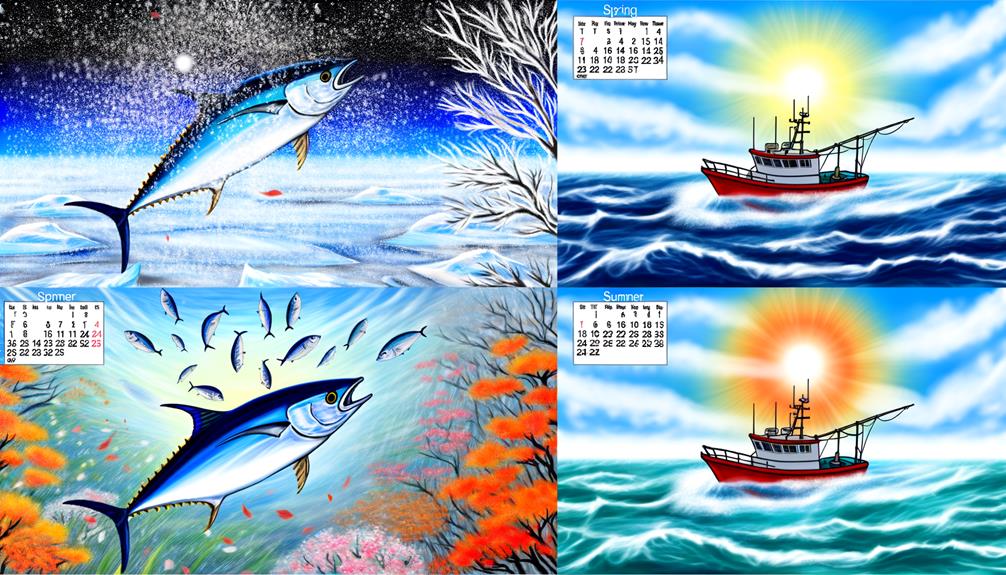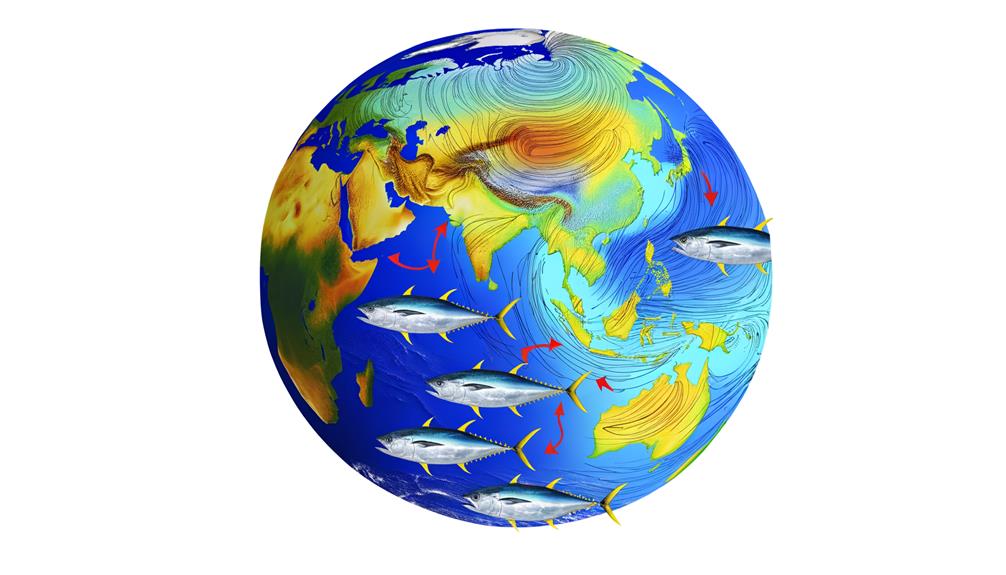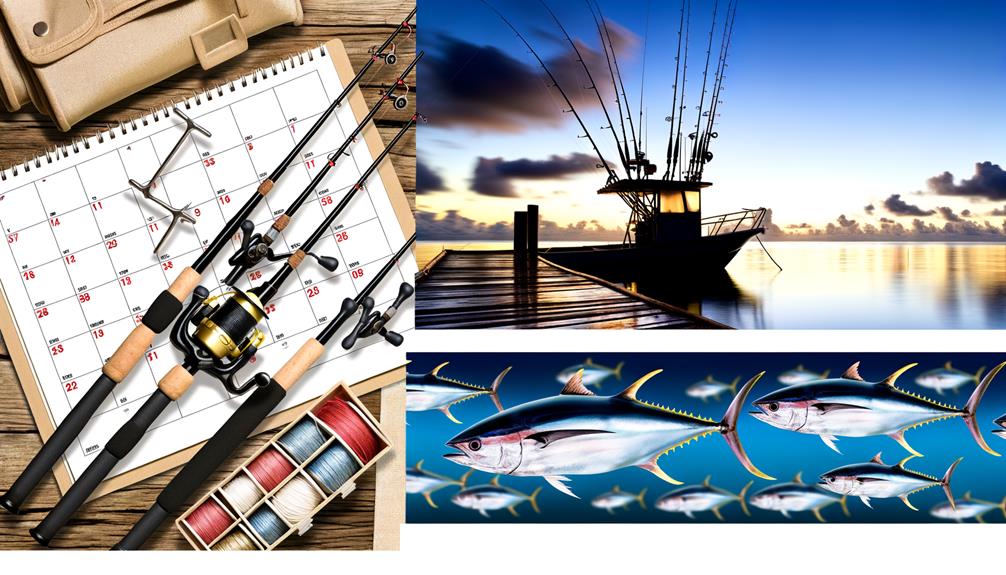Is it true that the start of tuna season is as predictable as the changing colors of autumn leaves? You'd think so, given the way some anglers mark their calendars. But as with many things in nature, it's not quite that simple.
Tuna season can shift based on a variety of factors, including geographical location, weather patterns, and even the specific species of tuna. Just when you think you've got it all figured out, you may find yourself surprised.
Interested in knowing more? Let's dive in.
Key Takeaways
- Tuna fishing seasons are influenced by factors such as geographical location, weather patterns, specific species of tuna, and state and federal regulations.
- Different types of tuna have specific seasons, such as yellowfin, blackfin, and bluefin tuna in Florida and Louisiana, various tuna species in California during July to September, and Atlantic bluefin tuna in Massachusetts and Texas during specific months.
- Understanding the seasonality of different tuna species is important for fishing success and to have unique fishing experiences in different regions.
- Climate change and variability can affect tuna seasons, including changes in water temperatures, distribution of tuna species, and shifts in the timing and duration of the fishing season. It is important to adapt strategies and anticipate these shifts in order to maximize fishing opportunities.
Understanding Tuna Fishing Seasons
To fully understand tuna fishing seasons, you must take into account a variety of factors, including location, weather patterns, and state and federal regulations, as they significantly influence the timing and duration of the season.
For instance, Florida's tuna fishing season runs from May to September, while Louisiana offers year-round opportunities due to its unique climate and geography.
If you're in California, your tuna fishing season starts in July, peaking during the balmy weather months, and ends in September. On the other hand, Massachusetts' season stretches from early June through November, with August and September being the prime months. The warm-blooded nature of tuna allows for such variation, making understanding tuna fishing seasons a complex matter.
Federal regulations also play a key role in determining when does tuna season start. These laws aim to ensure sustainable fishing practices, protecting not only the tuna species but also the livelihoods of those who depend on them. Therefore, it's crucial you familiarize yourself with these regulations before heading out to sea. Your adherence to these laws shows your commitment to preserving the environment and the fishing community.
Different Types of Tuna
Building on the understanding of tuna fishing seasons, it's essential you're aware of the different types of tuna you might encounter in various states during these periods. In Florida and Louisiana, for instance, you'll find yellowfin, blackfin, and bluefin, each unique in its characteristics.
California's season, running from July to September, is a prime time to engage with the different types of tuna that thrive in the balmy weather. In contrast, Massachusetts offers a broad range of tuna species, with Atlantic bluefin tuna being the most sought-after catch during the peak months of August and September.
Texas opens its Atlantic bluefin tuna season on July 1, closing November 30, subject to annual quota limitations. This specific focus on Atlantic bluefin demonstrates the importance of understanding the different tuna species, their diverse seasons, and the regions in which they can be found.
Seasonality of Bluefin Tuna

Understanding the seasonality of bluefin tuna can significantly enhance your fishing success, with each season offering unique opportunities and challenges.
The Bluefin Tuna Season varies based on the region, with each offering unique fishing experiences.
In Florida, the season lasts from May to September, offering year-round opportunities due to the state's reputation as a fishing capital and the diversity of tuna species.
Louisiana, on the other hand, offers year-round tuna fishing in diverse water bodies, with species like bluefin, yellowfin, and blackfin.
In California, the tuna fishing season starts in July and ends in September, the balmy weather during these months providing optimal fishing conditions.
Guidelines for Tuna Fishing
As you embark on your tuna fishing journey, it's crucial to understand the regulations governing this activity.
Not only does this involve the appropriate seasons, but also specific rules related to catch limits and fishing methods.
Equally important is the gear you'll need, which includes specific rods, reels, and bait to efficiently catch these robust species.
Tuna Fishing Regulations
Navigating the complex web of federal regulations, managed by the National Marine Fisheries Service, is a must if you're planning to venture into the world of tuna fishing. In the United States, these tuna fishing regulations ensure sustainable practices and vary by location and species.
For instance:
- Bluefin tuna fishing requires a specific permit and has strict quotas.
- Some areas have a minimum size limit for yellowfin and blackfin tuna.
- Certain fishing methods, like trolling with lures or using live bait, are regulated.
Understanding these regulations is crucial, so research and preparation are key. It's not just about casting a line; it's about belonging to a community that respects the ocean and its resources.
Essential Tuna Fishing Equipment
Now that you're familiar with the regulations, let's equip you with knowledge on the essential gear for tuna fishing. A heavy-duty rod and reel are integral to handle the strength and speed of this game fish. Strong lines withstand the powerful runs and dives of tuna.
Consider this table for a clear picture:
| Essential Tuna Fishing Equipment | Use | Season |
|---|---|---|
| – | – | – |
| Heavy-duty rod and reel | Handles strength and speed of tuna | All seasons |
| Strong fishing lines | Withstands tuna's power | All seasons |
| Lures | Attracts tuna | Spring, Fall |
| Live bait (mackerel, herring, squid) | Attracts tuna | Summer |
| Location knowledge | Ensures successful fishing trip | All seasons |
Impact of Climate on Tuna Season

Climate's impact on the tuna fishing season is significant, as it directly influences water temperatures, altering tuna migration patterns and feeding behavior. When you understand the effects of climate, you're in a better position to predict and adapt to changes in the tuna season.
Consider these key points:
- Warmer water temperatures in summer can increase tuna populations, improving fishing opportunities.
- Climate variability can change ocean currents and weather patterns, altering the timing and duration of the tuna season.
- Climate change can shift tuna species distribution, affecting traditional fishing seasons and locations.
The impact of climate on tuna season can't be underestimated. As a fisherman, it's vital to adapt your strategies and anticipate shifts in the season. Changes in climate have a direct bearing on where and when you'll find tuna.
Best Locations for Tuna Fishing
When it comes to optimal locations for tuna fishing, Florida tops the list, providing a robust fishing season from May to September and year-round opportunities due to its status as the fishing capital and its diverse range of tuna species.
Another contender is Louisiana, hosting year-round tuna fishing with a variety of species including yellowfin, blackfin, and bluefin tuna.
California also ranks high for the best locations for tuna fishing, with its season running from July to September. The state's balmy weather during these months offers perfect conditions for you to catch tuna.
For a chance to catch Pacific bluefin tuna, head to Massachusetts. The season starts in early June and extends through November, with prime months being August and September.
Lastly, don't overlook Texas. Its Atlantic bluefin tuna season opens on July 1 and closes on November 30th, offering you ample time to plan your fishing expedition.
Preparing for Tuna Fishing Season

Having chosen your prime destination for tuna fishing, it's crucial to gear up and prepare adequately for the season. To boost your success, you need a plan that's as precise as the 23 chromosomes that determine a bluefin's genetic makeup.
Firstly, get familiar with the specific tuna fishing season in your area. Start dates can vary, so a bit of research will keep you on the right side of the law.
Invest in the right gear. Tuna fishing requires:
- High-capacity reels and sturdy lines
- A variety of lures and baits
- Appropriate clothing for protection and comfort
Remember, bluefin are strong, fast swimmers so you need equipment that's up to the task.
Secondly, make sure to obtain the necessary permits and fishing licenses. Regulations differ by location, so be sure to stay informed and compliant. Fishing is more than just a sport; it's a responsibility.
Lastly, keep in mind that the time of day, the state of the tide, and the weather conditions can all impact your fishing results. By preparing well, you'll be ready to tackle the tuna season head-on.
Frequently Asked Questions
What Month Is Best for Tuna Fishing?
You'll find the best month for tuna fishing varies, reflecting tuna migration patterns, bait preferences, and tuna species variety. Generally, summer months are prime time, but it truly depends on your specific location.
How Long Is Gloucester Tuna Season?
You're curious about Gloucester's tuna season length. Typically, it starts in June and can extend till November, depending on weather conditions. Gloucester regulations aim to conserve tuna, mindful of the seasonal impact on populations.
How Long Is the Tuna Fishing Season on Wicked Tuna?
You're casting a wide net asking about the Wicked Tuna fishing season. It's influenced by fishing regulations, tuna species, and equipment necessities. The season varies, so stay in the loop for updates.
What Months Is Bluefin Tuna Season?
You're curious about bluefin tuna season. It generally starts in spring, following their migration north. However, it varies by location, aligning with sustainable fishing practices and considering tuna population trends. Research your area for specifics.
Conclusion
So, you've discovered that tuna fishing seasons vary by location.
For instance, Florida and Louisiana kick off in May, while California waits until July. The most interesting fact? Massachusetts's season spans from June through November, the longest amongst these states.
Understanding these differences can enhance your fishing adventures. Remember, climate impacts tuna migration, affecting seasonality. Hence, it's essential to stay informed and prepared.
Happy fishing!
